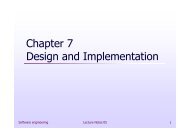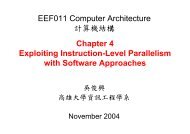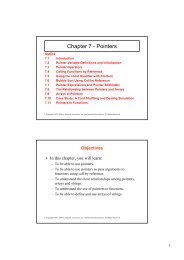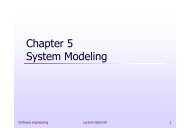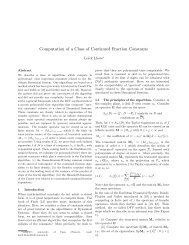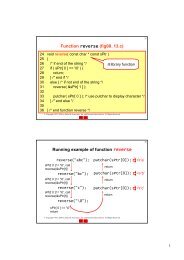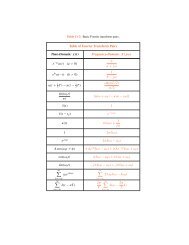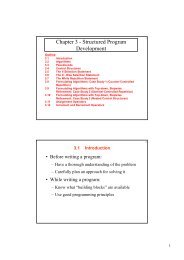Computer Architecture Chapter 1 Fundamentals of Computer Design
Computer Architecture Chapter 1 Fundamentals of Computer Design
Computer Architecture Chapter 1 Fundamentals of Computer Design
You also want an ePaper? Increase the reach of your titles
YUMPU automatically turns print PDFs into web optimized ePapers that Google loves.
<strong>Computer</strong> <strong>Architecture</strong><strong>Chapter</strong> 1<strong>Fundamentals</strong> <strong>of</strong> <strong>Computer</strong> <strong>Design</strong>
Outline•<strong>Computer</strong> Science at a Crossroads•<strong>Computer</strong> <strong>Architecture</strong> v. Instruction Set Arch.(1.3)•Trends in Technology (1.4)•Trends in Power (1.5)•Dependability (1.7)•Measuring, Reporting, and SummarizingPerformance (1.8)•Quantitative Principles <strong>of</strong> <strong>Design</strong> (1.9)2008/4/17 2
Crossroads: Uniprocessor Performance•VAX : 25%/year 1978 to 1986•RISC + x86: 52%/year 1986 to 2002•RISC + x86: ??%/year 2002 to present2008/4/17 3
What is <strong>Computer</strong> <strong>Architecture</strong>?S<strong>of</strong>twareHardwareApplication (IE)CompilerAssemblerProcessorMemoryOperatingSystem(MS Windows)Datapath & ControlI/O systemInstruction Set<strong>Architecture</strong>Digital <strong>Design</strong>Circuit <strong>Design</strong><strong>Computer</strong> <strong>Architecture</strong> = TransistorsInstruction Set <strong>Architecture</strong>+ Machine OrganizationMachineOrganization•Coordination <strong>of</strong> many levels <strong>of</strong> abstraction•Under a rapidly changing set <strong>of</strong> forces•<strong>Design</strong>, Measurement, andEvaluation2008/4/17 4
<strong>Computer</strong> <strong>Architecture</strong>•Instruction set design•Functional design•Logical design•Hardware implementation2008/4/17 5
Instruction Set <strong>Architecture</strong>•The actual programmer-visible instruction set•ISA serves as the boundary between the s<strong>of</strong>twareand hardware.•All recent ISAs are load-store, which can accessmemory only with load and store instructions.2008/4/17 6
Instruction Set <strong>Architecture</strong>: Critical Interfaces<strong>of</strong>twareinstruction sethardware•Properties <strong>of</strong> a good abstraction–Lasts through many generations (portability)–Used in many different ways (generality)–Provides convenient functionality to higher levels–Permits an efficient implementation at lower levels2008/4/17 7
ISA•Class <strong>of</strong> ISA:–register-memory for 80x86–Load-store•Memory addressing–Address A is aligned if A mod s =0•Addressing modes–Register, Immediate, and Displacement•Types and size <strong>of</strong> operands–8-bit, 16-bit, 32-bit, 64-bit•Operations–Data transfer, arithmetic logic, control, floating point•Control flow instructions–Conditional branch, unconditional jump, procedure call, return•Encoding an ISA–Fixed length, variable length2008/4/17 8
<strong>Computer</strong> as a State Machine•State: defined by storage–Registers, Memory, Disk, …•Next state is influenced by the operation–Instructions, I/O events, interrupts, …•When is the next state decided?–Result Store: Register write, Memory write–Output: Device (disk, network) writeCurrent Logical State<strong>of</strong> the MachineNext Logical State<strong>of</strong> the Machine2008/4/17 9
0r1°°°r31PClohiExample: MIPS0Arithmetic logicalAdd, AddU, Sub,Programmable storage2^32 x bytes31 x 32-bit GPRs (R0=0)32 x 32-bit FP regs (paired DP)HI, LO, PCSubU, And, Or, Xor, Nor, SLT, SLTU,AddI, AddIU, SLTI, SLTIU, AndI, OrI, XorI, LUISLL, SRL, SRA, SLLV, SRLV, SRAVMemory AccessControlLB, LBU, LH, LHU, LW, LWL,LWRSB, SH, SW, SWL, SWRJ, JAL, JR, JALRData types ?Format ?Addressing Modes?32-bit instructions on word boundaryBEq, BNE, BLEZ,BGTZ,BLTZ,BGEZ,BLTZAL,BGEZAL2008/4/17 10
MIPS Instruction Set <strong>Architecture</strong>Formats2008/4/17 11
Basic ISA ClassesAccumulator:1 address add A acc acc + mem[A]1+x address addx A acc acc + mem[A + x]Stack:0 address add tos tos + nextGeneral Purpose Register:2 address add A B EA(A) EA(A) + EA(B)3 address add A B C EA(A) EA(B) + EA(C)Load/Store:3 address add Ra Rb Rc Ra Rb + Rcload Ra Rb Ra mem[Rb]store Ra Rb mem[Rb] Ra2008/4/17 12
MIPS Addressing Modes & Formats•Simple addressing modes•All instructions 32 bits wideRegister (direct)op rs rt rdregisterImmediateop rs rtimmedBase+indexop rs rtimmedMemoryregister+PC-relativeop rs rtimmedMemoryPC+•Register Indirect?2008/4/17 13
Instruction Formats & RISCVariable:Fixed:Hybrid:…•Addressing modes–each operand requires addess specifier => variable format•Code size => variable length instructions•Performance => fixed length instructions–simple decoding, predictable operations•RISC: With load/store instruction arch, only one memory addressand few addressing modes => simple format, address mode givenby opcode (Why would RISC perform better than CISC?)2008/4/17 14
Cray-1: the Original RISCRegister-Register159865320OpRd Rs1 R2Load, Store and Branch15Op9 8 6 5 3 2 0 15 0Rd Rs1 Immediate2008/4/17 15
VAX-11: the Canonical CISCVariable format, 2 and 3 address instructionByte 0 1 n mOpCode A/M A/M A/M•Rich set <strong>of</strong> orthogonal address modes–immediate, <strong>of</strong>fset, indexed, autoinc/dec, indirect, indirect+<strong>of</strong>fset–applied to any operand•Simple and complex instructions–synchronization instructions–data structure operations (queues)–polynomial evaluation1. In programming, canonical means "according to the rules.”2. A canonical book is considered inspired and authoritative and is a part <strong>of</strong>the rule or standard <strong>of</strong> faith.2008/4/17 16
Load/Store <strong>Architecture</strong>s° 3-address GPR° Register-to-register arithmeticMEM° Load and store with simple addressing modes (reg +immediate)° Simple conditionalscompare ops + branch zcompare&branchcondition code + branch on condition° Simple fixed-format encodingopopopr r rregr r immed<strong>of</strong>fset° Substantial increase in instructions° Decrease in data BW (due to many registers)° Even more significant decrease in CPI (pipelining)° Cycle time, Real estate, <strong>Design</strong> time, <strong>Design</strong> complexity2008/4/17 17
MIPS R3000 ISA (Summary)•Instruction Categories– Load/Store– Computational– Jump and Branch– Floating Point» coprocessor– Memory Management– SpecialRegistersR0 - R31PCHILO3 Instruction Formats: all 32 bits wideOPrs rt rd sa functOPrs rt immediate2008/4/17 18OPjump target
Evolution <strong>of</strong> Instruction SetsSingle Accumulator (EDSAC 1950)Accumulator + Index Registers(Manchester Mark I, IBM 700 series 1953)Separation <strong>of</strong> Programming Modelfrom ImplementationHigh-level Language Based (Stack) Concept <strong>of</strong> a Family(B5000 1963) (IBM 360 1964)General Purpose Register MachinesComplex Instruction SetsLoad/Store <strong>Architecture</strong>(Vax, Intel 432 1977-80) (CDC 6600, Cray 1 1963-76)iX86?RISC(MIPS,Sparc,HP-PA,IBM RS6000, 1987)2008/4/17 19
Instruction Set <strong>Architecture</strong>“... the attributes <strong>of</strong> a [computing] system as seen bythe programmer, i.e. the conceptual structure andfunctional behavior, as distinct from the organization<strong>of</strong> the data flows and controls the logic design, andthe physical implementation.”–Amdahl, Blaauw, and Brooks, 1964-- Organization <strong>of</strong> ProgrammableStorage-- Data Types & Data Structures:Encodings & Representations-- Instruction Formats-- Instruction (or Operation Code) SetSOFTWARE-- Modes <strong>of</strong> Addressing and Accessing Data Items and Instructions-- Exceptional Conditions2008/4/17 20
<strong>Computer</strong> (Machine) Organization•Capabilities & PerformanceCharacteristics <strong>of</strong> Principal FunctionalUnits (FUs)–(Registers, ALU, Shifters, Logic Units, ...)•Ways in which these components areinterconnected (Bus, Network, …)•Information flows between components(Data, Messages, Packets, Data path)•Logic and means by which suchinformation flow is controlled (Controller,Protocol handler, Control path, Microcode)Logic <strong>Design</strong>er's ViewISA LevelFUs & Interconnect•Choreography <strong>of</strong> FUs to realize the ISA(Execution, Architectural description)•Register Transfer Level (RTL) Description(Implementation description)2008/4/17 21
ISA vs. <strong>Computer</strong> <strong>Architecture</strong>•Old definition <strong>of</strong> computer architecture= instruction set design–Other aspects <strong>of</strong> computer design called implementation–Insinuates implementation is uninteresting or less challenging•Our view is computer architecture >> ISA•Architect’s job much more than instruction setdesign; technical hurdles today more challengingthan those in instruction set design2008/4/17 22
Comp. Arch. is an Integrated Approach•What really matters is the functioning <strong>of</strong> the completesystem–hardware, runtime system, compiler, operating system, andapplication–In networking, this is called the “End to End argument”•<strong>Computer</strong> architecture is not just about transistors,individual instructions, or particular implementations–E.g., Original RISC projects replaced complex instructions with acompiler + simple instructions2008/4/17 23
<strong>Computer</strong> <strong>Architecture</strong> is<strong>Design</strong> and Analysis<strong>Design</strong><strong>Architecture</strong> is an iterative process:•Searching the space <strong>of</strong> possible designs•At all levels <strong>of</strong> computer systemsAnalysisCreativityCost /PerformanceAnalysisBad IdeasGood IdeasMediocre Ideas2008/4/17 24
Course FocusUnderstanding the design techniques, machinestructures, technology factors, evaluationmethods that will determine the form <strong>of</strong>computers in 21st CenturyApplicationsTechnologyParallelism<strong>Computer</strong> <strong>Architecture</strong>:•Organization•Hardware/S<strong>of</strong>tware BoundaryProgrammingLanguagesInterface <strong>Design</strong>(ISA)CompilersOperatingSystemsMeasurement &EvaluationHistory2008/4/17 25
Related CoursesOrgStrongPrerequisiteArchOtherHow to build itImplementation detailsBasic knowledge <strong>of</strong> theorganization <strong>of</strong> a computeris assumed!Why, Analysis,EvaluationParallel <strong>Architecture</strong>s,Languages, Systems2008/4/17 26
Course Requirement•Students without computer organizationequivalent may have to work hard;–Review: Appendix A, B, C; <strong>Computer</strong> Organization and <strong>Design</strong>(COD) 3/e2008/4/17 27
Outline•<strong>Computer</strong> Science at a Crossroads•<strong>Computer</strong> <strong>Architecture</strong> v. Instruction Set Arch.(1.3)•Trends in Technology (1.4)•Trends in Power (1.5)•Dependability (1.7)•Measuring, Reporting, and SummarizingPerformance (1.8)•Quantitative Principles <strong>of</strong> <strong>Design</strong> (1.9)2008/4/17 28
Moore’s Law: 2X transistors / “year”• “Cramming More Components onto Integrated Circuits”– Gordon Moore, Electronics, 1965• # on transistors / cost-effective integrated circuit double every N months (12 ≤N ≤24)2008/4/17 29
Tracking Technology Performance Trends•Drill down into 4 technologies:–Disks,–Memory,–Network,–Processors• Compare ~1980 Archaic (Nostalgic) vs.~2000 Modern (Newfangled)–Performance Milestones in each technology•Compare for Bandwidth vs. Latency improvementsin performance over time•Bandwidth: number <strong>of</strong> events per unit time–E.g., M bits / second over network, M bytes / second from disk•Latency: elapsed time for a single event– E.g., one-way network delay in microseconds,average disk access time in milliseconds2008/4/17 30
Disks: Archaic(Nostalgic) v. Modern(Newfangled)•CDC Wren I, 1983•3600 RPM•0.03 GBytes capacity•Tracks/Inch: 800•Bits/Inch: 9550•Three 5.25”platters•Bandwidth:0.6 MBytes/sec•Latency: 48.3 ms•Cache: none•Seagate 373453, 2003•15000 RPM (4X)•73.4 GBytes•Tracks/Inch: 64000•Bits/Inch: 533,000•Four 2.5”platters(in 3.5”form factor)(2500X)(80X)(60X)•Bandwidth:86 MBytes/sec (140X)•Latency: 5.7 ms•Cache: 8 MBytes(8X)2008/4/17 31
Latency Lags Bandwidth (for last ~20 years)10000•Performance Milestones1000RelativeBW100ImprovementDisk101(Latency improvement= Bandwidth improvement)1 10 100Relative Latency Improvement•Disk: 3600, 5400, 7200, 10000,15000 RPM (8x, 143x)(latency = simple operation w/o contentionBW = best-case)2008/4/17 32
Memory: Archaic (Nostalgic) v. Modern (Newfangled)•1980 DRAM(asynchronous)•0.06 Mbits/chip•64,000 xtors, 35 mm 2•16-bit data bus permodule, 16 pins/chip•13 Mbytes/sec•Latency: 225 ns•(no block transfer)•2000 Double Data Rate Synchr.(clocked) DRAM•256.00 Mbits/chip•256,000,000 xtors, 204 mm 2•64-bit data bus perDIMM, 66 pins/chip(4000X)(4X)•1600 Mbytes/sec (120X)•Latency: 52 ns•Block transfers (page mode)(4X)2008/4/17 33
Latency Lags Bandwidth (last ~20 years)10000•Performance Milestones1000RelativeBW100Improvement101MemoryDisk(Latency improvement= Bandwidth improvement)1 10 100•Memory Module: 16bit plainDRAM, Page Mode DRAM, 32b,64b, SDRAM,DDR SDRAM (4x,120x)•Disk: 3600, 5400, 7200, 10000,15000 RPM (8x, 143x)(latency = simple operation w/o contentionBW = best-case)Relative Latency Improvement2008/4/17 34
LANs: Archaic (Nostalgic)v. Modern (Newfangled)•Ethernet 802.3•Year <strong>of</strong> Standard: 1978•10 Mbits/slink speed•Latency: 3000 sec•Shared media•Coaxial cableCoaxial Cable:Plastic CoveringBraided outer conductorInsulatorCopper core•Ethernet 802.3ae•Year <strong>of</strong> Standard: 2003•10,000 Mbits/slink speed•Latency: 190 sec•Switched media(1000X)•Category 5 copper wire(15X)"Cat 5" is 4 twisted pairs in bundleTwisted Pair:Copper, 1mm thick,twisted to avoid antenna effect2008/4/17 35
Latency Lags Bandwidth (last ~20 years)10000•Performance Milestones1000RelativeBW100Improvement101MemoryNetworkDisk(Latency improvement= Bandwidth improvement)1 10 100Relative Latency Improvement•Ethernet: 10Mb, 100Mb,1000Mb, 10000 Mb/s (16x,1000x)•Memory Module: 16bit plainDRAM, Page Mode DRAM, 32b,64b, SDRAM,DDR SDRAM (4x,120x)•Disk: 3600, 5400, 7200, 10000,15000 RPM (8x, 143x)(latency = simple operation w/o contentionBW = best-case)2008/4/17 36
CPUs: Archaic (Nostalgic) v. Modern (Newfangled)•1982 Intel 80286•12.5 MHz•2 MIPS (peak)•Latency 320 ns•134,000 xtors, 47 mm 2•16-bit data bus, 68 pins•Microcode interpreter,separate FPU chip•(no caches)•2001 Intel Pentium 4•1500 MHz (120X)•4500 MIPS (peak) (2250X)•Latency 15 ns•42,000,000 xtors, 217 mm 2•64-bit data bus, 423 pins(20X)•3-way superscalar,Dynamic translate to RISC,Superpipelined (22 stage),Out-<strong>of</strong>-Order execution•On-chip 8KB Data caches,96KB Instr. Trace cache,256KB L2 cache2008/4/17 37
Latency Lags Bandwidth (last ~20 years)10000CPU high,Memory low(“MemoryWall”) 1000RelativeBW100Improvement101MemoryProcessorNetworkDisk(Latency improvement= Bandwidth improvement)1 10 100•Performance Milestones•Processor: ‘286, ‘386, ‘486,Pentium, Pentium Pro,Pentium 4 (21x,2250x)•Ethernet: 10Mb, 100Mb,1000Mb, 10000 Mb/s (16x,1000x)•Memory Module: 16bit plainDRAM, Page Mode DRAM, 32b,64b, SDRAM,DDR SDRAM (4x,120x)•Disk : 3600, 5400, 7200, 10000,15000 RPM (8x, 143x)Relative Latency Improvement2008/4/17 38
Rule <strong>of</strong> Thumb for Latency Lagging BW•In the time that bandwidth doubles, latencyimproves by no more than a factor <strong>of</strong> 1.2 to 1.4(and capacity improves faster than bandwidth)•Stated alternatively:Bandwidth improves by more than the square<strong>of</strong> the improvement in Latency2008/4/17 39
6 Reasons Latency Lags Bandwidth1. Moore’s Law helps BW more than latency• Faster transistors, more transistors,more pins help Bandwidth» MPU Transistors: 0.130 vs. 42 M xtors (300X)» DRAM Transistors: 0.064 vs. 256 M xtors (4000X)» MPU Pins: 68 vs. 423 pins (6X)» DRAM Pins: 16 vs. 66 pins (4X)• Smaller, faster transistors but communicateover (relatively) longer lines: limits latency» Feature size: 1.5 to 3 vs. 0.18 micron (8X,17X)» MPU Die Size: 35 vs. 204 mm 2 (ratio sqrt 2X)» DRAM Die Size: 47 vs. 217 mm 2 (ratio sqrt 2X)2008/4/17 40
6 Reasons Latency Lags Bandwidth (cont’d)2. Distance limits latency• Size <strong>of</strong> DRAM block long bit and word lines most <strong>of</strong> DRAM access time• Speed <strong>of</strong> light and computers on network• 1. & 2. explains linear latency vs. square BW?3. Bandwidth easier to sell (“bigger=better”)• E.g., 10 Gbits/s Ethernet (“10 Gig”) vs.10 sec latency Ethernet• 4400 MB/s DIMM (“PC4400”) vs. 50 ns latency• Even if just marketing, customers now trained• Since bandwidth sells, more resources thrown at bandwidth,which further tips the balance2008/4/17 41
6 Reasons Latency Lags Bandwidth (cont’d)4. Latency helps BW, but not vice versa• Spinning disk faster improves both bandwidth androtational latency» 3600 RPM 15000 RPM = 4.2X» Average rotational latency: 8.3 ms 2.0 ms» Things being equal, also helps BW by 4.2X• Lower DRAM latency More access/second (higher bandwidth)• Higher linear density helps disk BW(and capacity), but not disk Latency» 9,550 BPI 533,000 BPI 60X in BW2008/4/17 42
6 Reasons Latency Lags Bandwidth (cont’d)5. Bandwidth hurts latency• Queues help Bandwidth, hurt Latency (Queuing Theory)• Adding chips to widen a memory module increasesBandwidth but higher fan-out on address lines mayincrease Latency6. Operating System overhead hurtsLatency more than Bandwidth• Long messages amortize overhead;overhead bigger part <strong>of</strong> short messages2008/4/17 43
Summary <strong>of</strong> Technology Trends•For disk, LAN, memory, and microprocessor,bandwidth improves by square <strong>of</strong> latencyimprovement–In the time that bandwidth doubles, latency improves by no morethan 1.2X to 1.4X•Lag probably even larger in real systems, asbandwidth gains multiplied by replicated components–Multiple processors in a cluster or even in a chip–Multiple disks in a disk array–Multiple memory modules in a large memory–Simultaneous communication in switched LAN•HW and SW developers should innovate assumingLatency Lags Bandwidth–If everything improves at the same rate, then nothing really changes–When rates vary, require real innovation2008/4/17 44
Outline•<strong>Computer</strong> Science at a Crossroads•<strong>Computer</strong> <strong>Architecture</strong> v. Instruction Set Arch.(1.3)•Trends in Technology (1.4)•Trends in Power (1.5)•Dependability (1.7)•Measuring, Reporting, and SummarizingPerformance (1.8)•Quantitative Principles <strong>of</strong> <strong>Design</strong> (1.9)2008/4/17 45
Define and quantity power ( 1 / 2)•For CMOS chips, traditional dominant energyconsumption has been in switching transistors,called dynamic power21/2 CapacitiveLoadVoltageFrequencySwitched•For mobile devices, energy better metric2Energydynamic CapacitiveLoadVoltage•For a fixed task, slowing clock rate (frequencyswitched) reduces power, but not energyPowerdynamic•Capacitive load a function <strong>of</strong> number <strong>of</strong> transistorsconnected to output and technology, whichdetermines capacitance <strong>of</strong> wires and transistors•Dropping voltage helps both, so went from 5V to 1V•To save energy & dynamic power, most CPUs nowturn <strong>of</strong>f clock <strong>of</strong> inactive modules (e.g. Fl. Pt. Unit)2008/4/17 46
Example <strong>of</strong> quantifying power•Suppose 15% reduction in voltage results in a 15%reduction in frequency. What is impact on dynamicpower?Powerdynamic1/21/2(.85)0.6CapacitiveLoad.853CapacitiveLoadOldPowerOldPowerdynamicdynamicVoltage2FrequencySwitched(.85Voltage)2FrequencySwitched2008/4/17 47
Define and quantity power (2 / 2)•Because leakage current flows even when atransistor is <strong>of</strong>f, now static power important tooPowerstaticCurrentstatic Voltage•Leakage current increases in processors withsmaller transistor sizes•Increasing the number <strong>of</strong> transistors increasespower even if they are turned <strong>of</strong>f•In 2006, goal for leakage is 25% <strong>of</strong> total powerconsumption; high performance designs at 40%•Very low power systems even gate voltage toinactive modules to control loss due to leakage2008/4/17 48
Outline•<strong>Computer</strong> Science at a Crossroads•<strong>Computer</strong> <strong>Architecture</strong> v. Instruction Set Arch.(1.3)•Trends in Technology (1.4)•Trends in Power (1.5)•Dependability (1.7)•Measuring, Reporting, and SummarizingPerformance (1.8)•Quantitative Principles <strong>of</strong> <strong>Design</strong> (1.9)2008/4/17 49
Define and quantity dependability (1/3)• How decide when a system is operating properly?• Infrastructure providers now <strong>of</strong>fer Service LevelAgreements (SLA) to guarantee that theirnetworking or power service would be dependable• Systems alternate between 2 states <strong>of</strong> servicewith respect to an SLA:1. Service accomplishment, where the service isdelivered as specified in SLA2. Service interruption, where the delivered serviceis different from the SLA• Failure = transition from state 1 to state 2• Restoration = transition from state 2 to state 12008/4/17 50
Define and quantity dependability (2/3)• Module reliability = measure <strong>of</strong> continuous serviceaccomplishment (or time to failure).2 metrics1. Mean Time To Failure (MTTF) measures Reliability2. Failures In Time (FIT) = 1/MTTF, the rate <strong>of</strong> failures• Traditionally reported as failures per billion hours <strong>of</strong> operation• Mean Time To Repair (MTTR) measures ServiceInterruption– Mean Time Between Failures (MTBF) = MTTF+MTTR• Module availability measures service as alternatebetween the 2 states <strong>of</strong> accomplishment andinterruption (number between 0 and 1, e.g. 0.9)• Module availability = MTTF / ( MTTF + MTTR)2008/4/17 51
Example calculating reliability• If modules have exponentially distributedlifetimes (age <strong>of</strong> module does not affectprobability <strong>of</strong> failure), overall failure rate is thesum <strong>of</strong> failure rates <strong>of</strong> the modules• Calculate FIT and MTTF for 10 disks (1M hourMTTF per disk), 1 disk controller (0.5M hourMTTF), and 1 power supply (0.2M hour MTTF):FailureRateMTTF2008/4/17 52
Example calculating reliability• If modules have exponentially distributedlifetimes (age <strong>of</strong> module does not affectprobability <strong>of</strong> failure), overall failure rate is thesum <strong>of</strong> failure rates <strong>of</strong> the modules• Calculate FIT and MTTF for 10 disks (1M hourMTTF per disk), 1 disk controller (0.5M hourMTTF), and 1 power supply (0.2M hour MTTF):FailureRate 10(1/1,000,000)1/500,000 1/200,0001025/1,000,00017 /1,000,00017,000FITMTTF1,000,000,000 /17,00059,000hours2008/4/17 53
Outline•<strong>Computer</strong> Science at a Crossroads•<strong>Computer</strong> <strong>Architecture</strong> v. Instruction Set Arch.(1.3)•Trends in Technology (1.4)•Trends in Power (1.5)•Dependability (1.7)•Measuring, Reporting, and SummarizingPerformance (1.8)•Quantitative Principles <strong>of</strong> <strong>Design</strong> (1.9)2008/4/17 54
Definition: Performance•Performance is in units <strong>of</strong> things per sec–bigger is better•If we are primarily concerned with response timeperformance(x) = 1execution_time(x)" X is n times faster than Y" meansPerformance(X)n = =Performance(Y)Execution_time(Y)Execution_time(X)2008/4/17 55
Performance: What to measure•Usually rely on benchmarks vs. real workloads•To increase predictability, collections <strong>of</strong> benchmarkapplications, called benchmark suites, are popular•SPECCPU: popular desktop benchmark suite–CPU only, split between integer and floating point programs–SPECint2000 has 12 integer, SPECfp2000 has 14 integer pgms–SPECCPU2006 to be announced Spring 2006–SPECSFS (NFS file server) and SPECWeb (WebServer) added asserver benchmarks•Transaction Processing Council measures serverperformance and cost-performance for databases–TPC-C Complex query for Online Transaction Processing–TPC-H models ad hoc decision support–TPC-W a transactional web benchmark–TPC-App application server and web services benchmark2008/4/17 56
How Summarize Suite Performance (1/5)•Arithmetic average <strong>of</strong> execution time <strong>of</strong> all pgms?–But they vary by 4X in speed, so some would be more importantthan others in arithmetic average•Could add a weights per program, but how pickweight?–Different companies want different weights for their products•SPECRatio: Normalize execution times to referencecomputer, yielding a ratio proportional toperformance =time on reference computertime on computer being rated2008/4/17 57
How Summarize Suite Performance (2/5)•If program SPECRatio on <strong>Computer</strong> A is 1.25times bigger than <strong>Computer</strong> B, thenSPECRatio1.25 SPECRatioABExecutionTimeExecutionTimeBAExecutionTimeExecutionTimeExecutionTimeExecutionTimePerformancePerformancereferencereference•Note that when comparing 2 computers as a ratio,execution times on the reference computer dropout, so choice <strong>of</strong> reference computer is irrelevant2008/4/17 58ABAB
How Summarize Suite Performance (3/5)•Since ratios, proper mean is geometric mean(SPECRatio unitless, so arithmetic mean meaningless)GeometricMean2008/4/17 59nni1SPECRatio i1. Geometric mean <strong>of</strong> the ratios is the same as theratio <strong>of</strong> the geometric means2. Ratio <strong>of</strong> geometric means= Geometric mean <strong>of</strong> performance ratios choice <strong>of</strong> reference computer is irrelevant!• These two points make geometric mean <strong>of</strong> ratiosattractive to summarize performance
How Summarize Suite Performance (5/5)•Standard deviation is more informative if knowdistribution has a standard form–bell-shaped normal distribution, whose data are symmetricaround mean–lognormal distribution, where logarithms <strong>of</strong> data--not dataitself--are normally distributed (symmetric) on a logarithmicscale•For a lognormal distribution, we expect that68% <strong>of</strong> samples fall in range95% <strong>of</strong> samples fall in range•Note: Excel provides functions EXP(), LN(), andSTDEV() that make calculating geometric meanand multiplicative standard deviation easymean /meangstdev,meangstdev/ gstdev2 , meangstdev22008/4/17 61
Example Standard Deviation (1/2)•GM and multiplicative StDev <strong>of</strong> SPECfp2000 for Itanium 21400012000SPECfpRatio10000800060004000GM = 2712GSTEV = 1.98536220000wupwiseswimmgridapplumesagalgelartequakefacerecammplucasfma3dsixtrackapsi271213722008/4/17 62
Example Standard Deviation (2/2)•GM and multiplicative StDev <strong>of</strong> SPECfp2000 for AMD Athlon1400012000SPECfpRatio1000080006000400020000wupwiseswimmgridapplumesagalgelartequakefacerecammplucasfma3dsixtrackapsiGM = 2086GSTEV = 1.402911208614942008/4/17 63
Comments on Itanium 2 and Athlon•Standard deviation <strong>of</strong> 1.98 for Itanium 2 is muchhigher-- vs. 1.40--so results will differ morewidely from the mean, and therefore are likelyless predictable•Falling within one standard deviation:–10 <strong>of</strong> 14 benchmarks (71%) for Itanium 2–11 <strong>of</strong> 14 benchmarks (78%) for Athlon•Thus, the results are quite compatible with alognormal distribution (expect 68%)2008/4/17 64
Outline•<strong>Computer</strong> Science at a Crossroads•<strong>Computer</strong> <strong>Architecture</strong> v. Instruction Set Arch.(1.3)•Trends in Technology (1.4)•Trends in Power (1.5)•Dependability (1.7)•Measuring, Reporting, and SummarizingPerformance (1.8)•Quantitative Principles <strong>of</strong> <strong>Design</strong> (1.9)2008/4/17 65
Quantitative Principles <strong>of</strong> <strong>Design</strong>1.Take Advantage <strong>of</strong> Parallelism2.Principle <strong>of</strong> Locality3.Focus on the Common Case4.Amdahl’s Law5.The Processor PerformanceEquation2008/4/17 66
1) Taking Advantage <strong>of</strong> Parallelism•Increasing throughput <strong>of</strong> server computer viamultiple processors or multiple disks•Detailed HW design–Carry lookahead adders uses parallelism to speed up computingsums from linear to logarithmic in number <strong>of</strong> bits per operand–Multiple memory banks searched in parallel in set-associativecaches•Pipelining: overlap instruction execution to reducethe total time to complete an instruction sequence.–Not every instruction depends on immediate predecessor executing instructions completely/partially in parallel possible–Classic 5-stage pipeline:1) Instruction Fetch (Ifetch),2) Register Read (Reg),3) Execute (ALU),4) Data Memory Access (Dmem),5) Register Write (Reg)2008/4/17 67
Pipelined Instruction ExecutionTime (clock cycles)Instr.Cycle 1 Cycle 2 Cycle 3 Cycle 4 Cycle 5 Cycle 6 Cycle 7IfetchRegIfetchALURegDMemALURegDMemRegOrderIfetchRegIfetchALURegDMemALURegDMemReg2008/4/17 68
Limits to pipelining•Hazards prevent next instruction from executingduring its designated clock cycle–Structural hazards: attempt to use the same hardware to dotwo different things at once–Data hazards: Instruction depends on result <strong>of</strong> priorinstruction still in the pipeline–Control hazards: Caused by delay between the fetching <strong>of</strong>instructions and decisions about changes in control flow(branches and jumps). Time (clock cycles)Instr.IfetchRegIfetchOrIfetch RegDMem Regder2008/4/17 69ALURegIfetchDMemALURegRegDMemALURegDMemALUReg
2) The Principle <strong>of</strong> Locality•The Principle <strong>of</strong> Locality:–Program access a relatively small portion <strong>of</strong> the address space atany instant <strong>of</strong> time.•Two Different Types <strong>of</strong> Locality:–Temporal Locality (Locality in Time): If an item is referenced, it willtend to be referenced again soon (e.g., loops, reuse)–Spatial Locality (Locality in Space): If an item is referenced, itemswhose addresses are close by tend to be referenced soon(e.g., straight-line code, array access)•Last 30 years, HW relied on locality for memory perf.P$MEM2008/4/17 70
CapacityAccess TimeCostLevels <strong>of</strong> the Memory HierarchyCPU Registers100s Bytes300 –500 ps (0.3-0.5 ns)L1 and L2 Cache10s-100s K Bytes~1 ns - ~10 ns$1000s/ GByteMain MemoryG Bytes80ns- 200ns~ $100/ GByteDisk10s T Bytes, 10 ms(10,000,000 ns)~ $1 / GByteRegistersL1 CacheMemoryDiskInstr. OperandsBlocksL2 CacheBlocksPagesFilesStagingXfer Unitprog./compiler1-8 bytescache cntl32-64 bytescache cntl64-128 bytesOS4K-8K bytesuser/operatorMbytesUpper LevelfasterTapeinfiniteTapesec-min~$1 / GByte2008/4/17 71LargerLower Level
3) Focus on the Common Case•Common sense guides computer design–Since its engineering, common sense is valuable•In making a design trade-<strong>of</strong>f, favor the frequentcase over the infrequent case–E.g., Instruction fetch and decode unit used more frequentlythan multiplier, so optimize it 1st–E.g., If database server has 50 disks / processor, storagedependability dominates system dependability, so optimize it 1st•Frequent case is <strong>of</strong>ten simpler and can be donefaster than the infrequent case–E.g., overflow is rare when adding 2 numbers, so improveperformance by optimizing more common case <strong>of</strong> no overflow–May slow down overflow, but overall performance improved byoptimizing for the normal case•What is frequent case and how much performanceimproved by making case faster => Amdahl’s Law2008/4/17 72
4) Amdahl’s LawExTimenewExTimeold 1FractionenhancedFraction enhancedSpeedupenhancedSpeedupoverallExTimeExTimeoldnew1Fractionenhanced1FractionSpeedupenhancedenhancedBest you could ever hope to do:Speedupmaximum11 - Fractionenhanced2008/4/17 73
Amdahl’s Law example•New CPU 10X faster•I/O bound server, so 60% time waiting for I/OSpeedupoverall11Fraction10.40.410enhanced1FractionSpeedup10.641.56enhancedenhanced•Apparently, its human nature to be attracted by 10Xfaster, vs. keeping in perspective its just 1.6X faster2008/4/17 74
5) Processor performance equationCPIinst count Cycle timeCPU CPUtime = Seconds = Instructions x Cycles Cycles x SecondsProgram Program Instruction Cycle CycleInst Count CPI Clock RateProgram XCompiler X (X)Inst. Set. X XOrganization X XTechnologyX2008/4/17 75
What’s a Clock Cycle?Latchorregistercombinationallogic2008/4/17 76
Summary•<strong>Computer</strong> <strong>Architecture</strong> >> instruction sets•<strong>Computer</strong> <strong>Architecture</strong> skill sets are different–5 Quantitative principles <strong>of</strong> design2008/4/17 77




